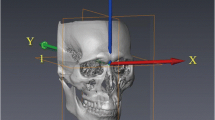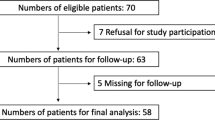Abstract
Objectives
Although several studies have reported the advantages of the surgery-first approach for orthognathic correction of Class III deformity, there are few reports of the success of this approach for patients with facial asymmetry. Therefore, the purpose of this study was to evaluate the outcome of bimaxillary surgery for asymmetric skeletal Class III deformity using a surgery-first approach.
Materials and methods
Sixty-five patients who consecutively underwent at least a combined Le Fort I and a bilateral sagittal split osteotomy for asymmetric skeletal Class III deformity were identified in the authors’ patient database. Standardized frontal photographs were used to measure the change in midface, intercommissural line, chin from midface, and chin deviation angles as well as upper, middle, and lower contour deviation angles. The facial midline symmetry index, facial contour symmetry index, and overall facial symmetry index were also calculated. Self-reported questionnaires regarding overall appearance and satisfaction with facial areas were administered at least 1 year post-surgery.
Results
Forty-six patients had genioplasty. There was a statistically significant improvement in the deviation angles measured and the facial midline, facial contour, and overall facial symmetry index. Self-reported questionnaires, completed at least 1 year post-surgery, showed that patient satisfaction was high.
Conclusions
These findings demonstrate that the surgical-orthodontic treatment with surgery-first approach can successfully maintain or improve facial symmetry.
Clinical relevance
The surgery-first approach for improving facial asymmetry using the guidelines described for setups of the models is a feasible alternative to the classic orthodontic-first approach for bimaxillary orthognathic surgery.





Similar content being viewed by others
References
Zingler S, Hakim E, Finke D, Brunner M, Saure D, Hoffmann J, Lux CJ, Erber R, Seeberger R (2017) Surgery-first approach in orthognathic surgery: psychological and biological aspects—a prospective cohort study. J Craniomaxillofac Surg 45:1293–1301
Yang L, Xiao YD, Liang YJ, Wang X, Li JY, Liao GQ (2017) Does the surgery-first approach produce better outcomes in orthognathic surgery? A systematic review and meta-analysis. J Oral Maxillofac Surg 75:2422–2429
Liao YF, Chiu YT, Huang CS, Ko EW, Chen YR (2010) Presurgical orthodontics versus no presurgical orthodontics: treatment outcome of surgical-orthodontic correction for skeletal class III open bite. Plast Reconstr Surg 126:2074–2083
Liou EJW, Chen PH, Wang YC, Yu CC, Huang CS, Chen YR (2011) Surgery-first accelerated orthognathic surgery: orthodontic guidelines and setup for model surgery. J Oral Maxillofac Surg 69:771–780
Chew MT (2006) Spectrum and management of dentofacial deformities in a multiethnic Asian population. Angle Orthod 76:806–809
Ko EWC, Hsu SSP, Hsieh HY, Wang YC, Huang CS, Chen YR (2011) Comparison of progressive cephalometric changes and postsurgical stability of skeletal Class III correction with and without presurgical orthodontic treatment. J Oral Maxillofac Surg 69:1469–1477
Joh B, Bayome M, Park JH, Park JU, Kim Y, Kook YA (2013) Evaluation of minimal versus conventional presurgical orthodontics in skeletal Class III patients treated with two-jaw surgery. J Oral Maxillofac Surg 71:1733–1741
Zhou Y, Li Z, Wang X, Zou B, Zhou Y (2016) Progressive changes in patients with skeletal Class III malocclusion treated by 2-jaw surgery with minimal and conventional presurgical orthodontics: a comparative study. Am J Orthod Dentofac Orthop 149:244–252
Hunsuck EE (1968) A modified intra-oral sagittal splitting technique for correction of mandibular prognathism. J Oral Surg 26:250–253
Chen YA, Ng LS, Ko EW, Chen YR (2017) Mandibular contouring during orthognathic surgery using the modified hunsuck technique. J Craniofac Surg 28:239–240
Bell WH (1992) Modern practice in orthognathic and reconstructive surgery. Saunders, Philadelphia
Yu CC, Bergeron L, Lin CH, Chu YM, Chen YR (2009) Single-splint technique in orthognathic surgery: intraoperative checkpoints to control facial symmetry. Plast Reconstr Surg 24:879–886
Ettorre G, Weber M, Schaaf H, Lowry JC, Mommaerts MY, Howaldt HP (2006) Standards for digital photography in cranio-maxillo-facial surgery—part I: basic views and guidelines. J Craniomaxillofac Surg 34:65–73
Schaaf H, Streckbein P, Ettorre G, Lowry JC, Mommaerts MY, Howaldt HP (2006) Standards for digital photography in cranio-maxillo-facial surgery—part II: additional picture sets and avoiding common mistakes. J Craniomaxillofac Surg 34:366–377
Lee LW, Chen SH, Yu CC, Lo LJ, Lee SR, Chen YR (2007) Stigma, body image, and quality of life in women seeking orthognathic surgery. Plast Reconstr Surg 120:225–231
Ko EWC, Huang CS, Chen YR (2009) Characteristics and corrective outcome of face asymmetry by orthognathic surgery. J Oral Maxillofac Surg 67:2201–2209
Hagensli N, Stenvik A, Espeland L (2014) Asymmetric mandibular prognathism: outcome, stability and patient satisfaction after BSSO surgery. A retrospective study. J Craniomaxillofac Surg 42:1735–1741
Hwang HS, Min YS, Lee SC, Sun MK, Lim HS (2009) Change of lip-line cant after 1-jaw orthognathic surgery in patients with mandibular asymmetry. Am J Orthod Dentofac Orthop 136:564–569
Kim YH, Jeon J, Rhee JT, Hong J (2010) Change of lip cant after bimaxillary orthognathic surgery. J Oral Maxillofac Surg 68:1106–1111
Wu TY, Lin HH, Lo LJ, Ho CT (2017) Postoperative outcomes of two- and three-dimensional planning in orthognathic surgery: a comparative study. J Plast Reconstr Aesthet Surg 70:1101–1111
Hajeer MY, Ayoub AF, Millett DT (2004) Three-dimensional assessment of facial soft-tissue asymmetry before and after orthognathic surgery. Br J Oral Maxillofac Surg 42:396–404
De Riu G, Meloni SM, Baj A, Corda A, Soma D, Tullio A (2014) Computer-assisted orthognathic surgery for correction of facial asymmetry: results of a randomised controlled clinical trial. Br J Oral Maxillofac Surg 52:251–257
Suzuki-Okamura E, Higashihori N, Kawamoto T, Moriyama K (2015) Three-dimensional analysis of hard and soft tissue changes in patients with facial asymmetry undergoing 2-jaw surgery. Oral Surg Oral Med Oral Pathol Oral Radiol 120:299–306
Freudlsperger C, Rückschloß T, Ristow O, Bodem J, Kargus S, Seeberger R, Engel M, Hoffmann J, Mertens C (2017) Effect of occlusal plane correction on lip cant in two-jaw orthognathic surgery—a three-dimensional analysis. J Craniomaxillofac Surg 45:1026–1030
Severt TR, Proffit WR (1997) The prevalence of facial asymmetry in the dentofacial deformities population at the University of North Carolina. Int J Adult Orthod Orthognath Surg 12:171–176
Chung C, Lee Y, Park KH, Park SH, Park YC, Kim KH (2008) Nasal changes after surgical correction of skeletal Class III malocclusion in Koreans. Angle Orthod 78:427–432
Baik HS, Kim SY (2010) Facial soft-tissue changes in skeletal Class III orthognathic surgery patients analyzed with 3-dimensional laser scanning. Am J Orthod Dentofac Orthop 138:167–178
Park SB, Yoon JK, Kim YI, Hwang DS, Cho BH, Son WS (2012) The evaluation of the nasal morphologic changes after bimaxillary surgery in skeletal Class III maloccusion by using the superimposition of cone-beam computed tomography (CBCT) volumes. J Craniomaxillofac Surg 40:e87–e92
Kim BR, Oh KM, Cevidanes LHS, Park JE, Sim HS, Seo SK, Reyes M, Kim YJ, Park YH (2013) Analysis of 3D soft tissue changes after 1- and 2-jaw orthognathic surgery in mandibular prognathism patients. J Oral Maxillofac Surg 71:151–161
Metzler P, Geiger EJ, Chang CC, Sirisoontorn I, Steinbacher DM (2014) Assessment of three-dimensional nasolabial response to Le Fort I advancement. J Plast Reconstr Aesthet Surg 67:756–763
Ho CT, Lin HH, Liou EJ, Lo LJ (2017) Three-dimensional surgical simulation improves the planning for correction of facial prognathism and asymmetry: a qualitative and quantitative study. Sci Rep 7:40423
You KH, Lee KJ, Lee SH, Baik HS (2010) Three-dimensional computed tomography analysis of mandibular morphology in patients with facial asymmetry and mandibular prognathism. Am J Orthod Dentofac Orthop 138:540.e1–540.e8
Lee H, Bayome M, Kim SH, Kim KB, Behrents RG, Kook YA (2012) Mandibular dimensions of subjects with asymmetric skeletal Class III malocclusion and normal occlusion compared with cone-beam computed tomography. Am J Orthod Dentofac Orthop 142:179–185
Funding
The work was supported by the Chang Gung Memorial Hospital, Taiwan (CMRPG5C0113).
Author information
Authors and Affiliations
Corresponding author
Ethics declarations
Conflict of interest
All authors declare that they have no conflict of interest.
Ethical approval
The study protocol was approved by the Ethics Committee for Human Research, Chang Gung Memorial Hospital, Taoyuan, Taiwan.
Informed consent
Informed consent was not needed due to the retrospective design of the study.
Rights and permissions
About this article
Cite this article
Liao, YF., Chen, YF., Yao, CF. et al. Long-term outcomes of bimaxillary surgery for treatment of asymmetric skeletal class III deformity using surgery-first approach. Clin Oral Invest 23, 1685–1693 (2019). https://doi.org/10.1007/s00784-018-2603-y
Received:
Accepted:
Published:
Issue Date:
DOI: https://doi.org/10.1007/s00784-018-2603-y




